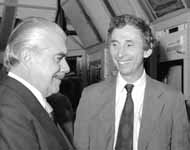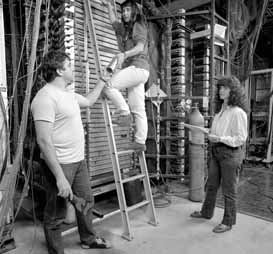 |
|
Brazil 500
Its modern-day borders encompass nearly half the continent of South America. It is home to the world's second-longest river, the 3,900-mile Amazon. No one's day would be quite the same without one of its major exports: it is the world's leading producer of coffee.
Particle physics has played a critical role in the development of Brazilian science for nearly 70 years, and the connection with Fermilab has helped encourage the growth of Brazilian particle physics for nearly 20 years.
In 1983, Brazilian physicists organized a conference to consider the possibility of joining international research collaborations at the high-energy frontiers of particle physics. Among those attending was Leon Lederman, then Director of Fermilab. Lederman offered his support and helped to establish a Brazilian presence at Fermilab. Soon the first Brazilian contingent--five physicists and an engineer--made the transcontinental journey to Batavia, Illinois.
In the 1930s, physicists Gleb Wathagin, Paulus A. Pompeia and Marcelo Damy de Souza Santos did pioneering work at the University of Sao Paulo. They identified characteristic features of cosmic rays created by particles entering the earth's atmosphere.
In 1947, Cesar Lattes and G.P.S. Occhialini participated in C.F. Powell's Nobel Prize-winning experiments in the Bolivian Andes, using photo-graphic plates to study the processes leading to the production of secondary particles in cosmic rays. They discovered the pion, an unstable particle seven times lighter than a proton. Today, we know the pion as the lightest meson, or quark-antiquark combination.
In 1949, Lattes founded the Centro Brazileiro de Pesquisas Fisicas (CBPF), a research center devoted to both experimental and theoretical physics. He continued his own research in particle physics at Chacaltaya peak in Bolivia, using nuclear emulsions to record and analyze the tracks of cosmic particles. Today, CBPF has 28 collaborators on Fermilab experiments.
As Fermilab embarks upon Collider Run II of the Tevatron in 2001, Brazilian scientists will continue their contributions to the new physics of the 21st Century. And Brazilian coffee will help jump-start the day for scientists and non-scientists the world over. |
| last modified 11/10/2000 email Fermilab |
FRLsDFx9eyfrPXgV
 Brazil celebrates its 500th anniversary this year, commemorating the claim of the explorer Pedro Alvares Cabral for Portugal in 1500. The festivities extend to Fermilab with a Nov. 11 performance in Ramsey Auditorium by Anima, six musicians who demonstrate the merging of medieval European music with that of Africa and of the land's indigenous peoples, resulting in the rich musical heritage of modern-day Brazil. Fermilab also will be graced by the presence of Ambassador Alexandre Addor, Consul General of Brazil.
Brazil celebrates its 500th anniversary this year, commemorating the claim of the explorer Pedro Alvares Cabral for Portugal in 1500. The festivities extend to Fermilab with a Nov. 11 performance in Ramsey Auditorium by Anima, six musicians who demonstrate the merging of medieval European music with that of Africa and of the land's indigenous peoples, resulting in the rich musical heritage of modern-day Brazil. Fermilab also will be graced by the presence of Ambassador Alexandre Addor, Consul General of Brazil.
 Since then, Brazilian scientists have participated in both fixed-target and colliding-beam experiments, and today Brazil's Fermilab collaboration numbers 43 physicists and students. They are involved in data analysis, software and hardware development, detector design and the production of detector components. Graduate students receive training both at their home universities and Fermilab, capitalizing on the opportunity to work at the high-energy frontier and continuing a legacy of discovery extending to the earliest history of the field.
Since then, Brazilian scientists have participated in both fixed-target and colliding-beam experiments, and today Brazil's Fermilab collaboration numbers 43 physicists and students. They are involved in data analysis, software and hardware development, detector design and the production of detector components. Graduate students receive training both at their home universities and Fermilab, capitalizing on the opportunity to work at the high-energy frontier and continuing a legacy of discovery extending to the earliest history of the field.